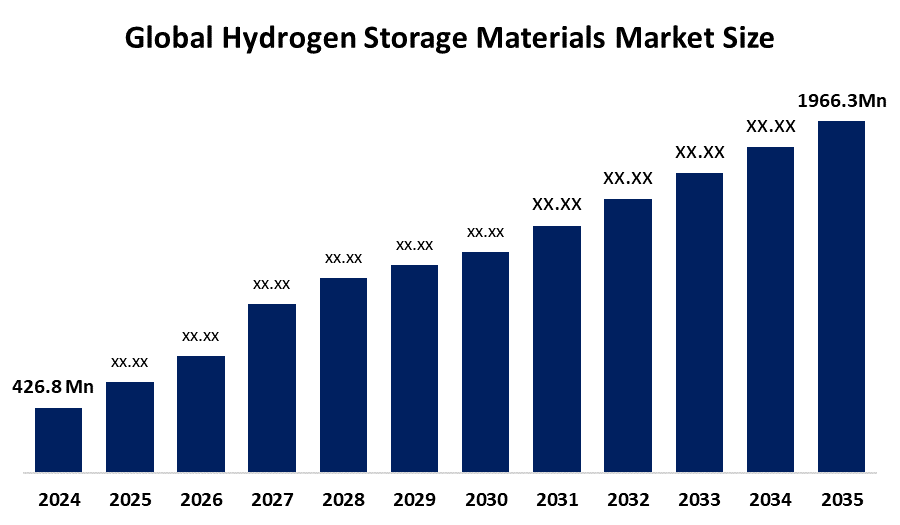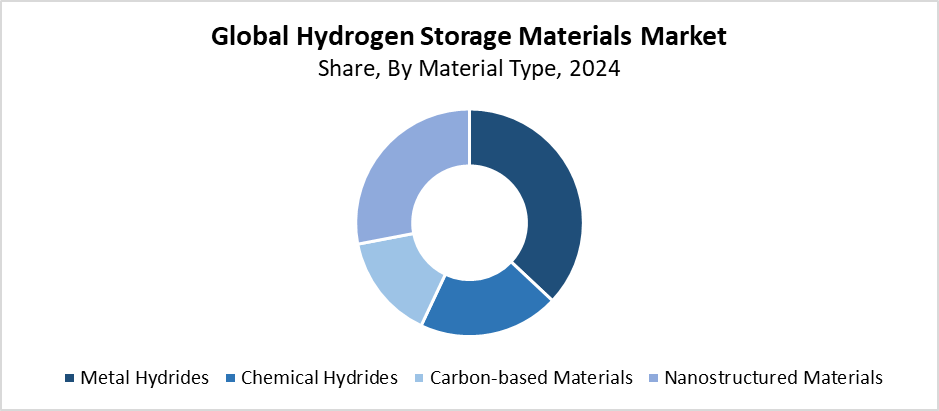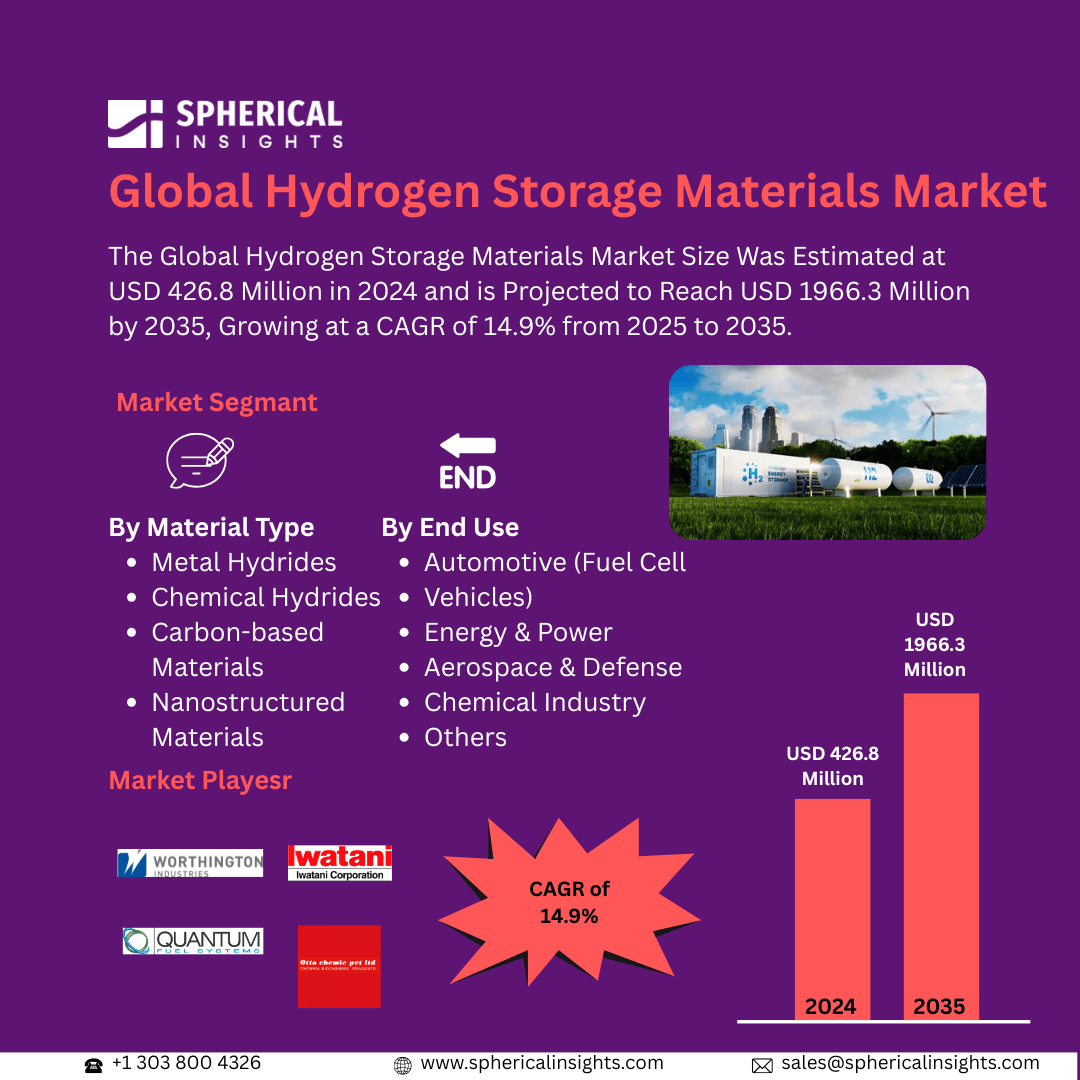Hydrogen Storage Materials Market Summary
The Global Hydrogen Storage Materials Market Size Was Estimated at USD 426.8 Million in 2024 and is Projected to Reach USD 1966.3 Million by 2035, Growing at a CAGR of 14.9% from 2025 to 2035. The market for hydrogen storage materials is expanding as a result of the increased use of hydrogen in transportation and energy, government support for clean energy, improvements in storage technologies, rising fuel cell demand, and the need for high-capacity, safe, and effective hydrogen storage solutions.
Key Regional and Segment-Wise Insights
- In 2024, the Asia Pacific hydrogen storage materials market held the largest revenue share of 38.2% and dominated the global market.
- In 2024, the metal hydrides segment held the highest revenue share of 37.7% and dominated the global market by material type.
- With the biggest revenue share of 32.8% in 2024, the automotive (fuel cell vehicles) segment led the worldwide hydrogen storage materials market by end use.
Global Market Forecast and Revenue Outlook
- 2024 Market Size: USD 426.8 Million
- 2035 Projected Market Size: USD 1966.3 Million
- CAGR (2025-2035): 14.9%
- Asia Pacific: Largest market in 2024

The hydrogen storage materials market exists to produce and distribute materials which store hydrogen safely for industrial applications, transportation, and energy needs. The materials used for hydrogen storage at various pressure and temperature levels consist of metal hydrides, chemical hydrides, porous materials, and carbon-based structures. The market expansion receives its main support from worldwide initiatives to cut carbon emissions, build clean energy systems, and the rising adoption of hydrogen fuel cells in vehicles, power generation, and the expanding requirement for sustainable energy storage solutions. The rising environmental concerns, together with stricter emission regulations, have prompted governments and businesses to back hydrogen energy systems. This leads to growing global demand for advanced hydrogen storage solutions.
Technological progress has brought about essential changes to the market for hydrogen storage materials. The development of porous nanomaterials together with high-capacity chemical storage compounds and lightweight metal hydrides has improved both safety and effectiveness and absorption rates for hydrogen. The clean energy transition receives support from North American, European, and Asia-Pacific governments through their financial initiatives, incentive programs and regulatory frameworks. These promote hydrogen adoption. The development of affordable, long-lasting, and high-performing hydrogen storage technologies is being accelerated by cooperative research projects, pilot programs, and public-private partnerships. The technology has reached a stage where it can now be widely used for commercial purposes in energy systems, transportation infrastructure, and industrial facilities.
Material Type Insights

The metal hydrides segment led the hydrogen storage materials market by holding the largest revenue share of 37.7% in 2024. Metal hydrides serve as the preferred choice because they provide substantial hydrogen storage capabilities and operate safely while managing hydrogen absorption and release at typical pressure and temperature conditions. These materials serve as essential components in fuel cells and hydrogen-powered vehicles, and stationary energy storage systems. The segment continues to grow because researchers work on improving battery cycling stability, storage efficiency, and weight reduction. The world market for metal hydride hydrogen storage materials grows because hydrogen functions as a clean energy source, and governments support renewable energy through incentives. Businesses fund sustainable energy projects.
The nanostructured materials segment is expected to grow at the fastest CAGR during the forecast period because of its high surface area and improved absorption-desorption kinetics, and increased hydrogen storage capabilities. These materials, which include metal-organic frameworks (MOFs), graphene, and carbon nanotubes, provide reversible, lightweight, and effective hydrogen storage options, making them ideal for applications including renewable energy, portable power, and mobility. The segment experiences rapid growth because ongoing research and development efforts concentrate on better storage density and thermal stability, and cost reduction. The forecast period will see nanostructured material demand rise worldwide because industries need advanced hydrogen storage systems.
End Use Insights
The automotive (fuel cell vehicles) segment led the hydrogen storage materials in 2024 by holding the largest revenue share of 32.8%. The leadership position exists because hydrogen fuel cell vehicles (FCVs) have gained acceptance as alternatives to traditional internal combustion engine vehicles, while emission standards worldwide have become stricter, and environmental issues keep growing. The safe and effective hydrogen fuel storage at high-density levels through FCVs depends on hydrogen storage materials because they enable optimal vehicle performance and maximum driving range. The automotive industry demands advanced hydrogen storage solutions because government funding, hydrogen infrastructure development, and automotive material manufacturer collaborations with car manufacturers have created a market-dominant position for the industry.
The energy and power segment is anticipated to experience substantial growth through the forecast period because sustainable clean energy storage solutions have become increasingly essential. Hydrogen storage materials function as essential elements for large-scale energy storage systems because they enable power generation and grid balancing, and renewable energy integration through efficient hydrogen storage and release. The segment grows because of increasing investments in fuel cell technology, microgrid projects, and hydrogen power plant construction. The implementation of hydrogen storage systems progresses at a fast rate because governments support decarbonization and energy transition initiatives, and scientific progress has created safe, high-capacity hydrogen storage materials. The energy and power industry has established a robust foundation through this pattern.
Regional Insights
The Asia Pacific region led the hydrogen storage materials market globally by holding the largest revenue share of 38.2% in 2024. The main reasons for this leadership position stem from fast industrial development and expanding energy, automotive sectors, and growing clean energy infrastructure spending in China, Japan, South Korea, and India. The region's market growth depends on three main factors, which include its substantial research into new hydrogen storage materials and its supportive regulatory environment. It's dedication to hydrogen fuel cell development. The market position is further reinforced by the rising demand for fuel cell vehicles, the integration of renewable energy sources, and large-scale hydrogen storage solutions. The region's large producers and centres of technological innovation guarantee the market's sustained dominance in hydrogen storage materials.
North America Hydrogen Storage Materials Market Trends
The North American hydrogen storage material market experiences steady growth because hydrogen fuel cells find expanding applications across industrial operations, power generation, and transportation systems. The region receives strong government support through financial programs, tax incentives, and regulatory systems that support sustainable energy and carbon reduction initiatives. The market acceptance of metal hydrides, chemical hydrides, and nanostructured materials has grown because technological advancements have enhanced their performance, safety, and storage efficiency. The development and commercialisation of hydrogen storage technologies advances through active partnerships which unite major automotive manufacturers with energy companies. Academic research institutions also participate. The North American market for hydrogen storage materials continues to grow because of renewable energy project funding, hydrogen infrastructure development, and rising environmental sustainability awareness.
Europe Hydrogen Storage Materials Market Trends
The European hydrogen storage material market experiences significant growth because of strict environmental rules and strong government backing for green energy transitions. The United Kingdom, France, and Germany lead the way with hydrogen technology deployment across industrial operations and power generation, and transportation systems. The industry growth stems from increasing fuel cell vehicle investment, together with renewable energy integration, and large-scale hydrogen storage development programs. Scientists have made storage systems more cost-effective, safe, and efficient through their work on chemical hydrides, high-capacity metal hydrides, and nanostructured materials. Research initiatives and public-private partnerships, together with supportive regulations, are accelerating hydrogen storage technology commercialisation. This positions Europe as a leading market for advanced hydrogen storage solutions.
Key Hydrogen Storage Materials Companies:
The following are the leading companies in the hydrogen storage materials market. These companies collectively hold the largest market share and dictate industry trends.
- Otto Chemie Pvt. Ltd.
- Iwatani Corporation
- Luxfer Holdings PLC
- NIPPON DENKO CO., LTD.
- Quantum Fuel Systems
- GKN Hydrogen GmbH
- Worthington Industries
- Hexagon Composites ASA
- Steelhead Composites, Inc.
- Others
Recent Developments
- In December 2024, for stationary energy storage systems, Panasonic Corporation is spending money on research and development to enhance the functionality and robustness of hydrogen storage materials.
Market Segment
This study forecasts revenue at global, regional, and country levels from 2020 to 2035. Decision Advisors has segmented the hydrogen storage materials market based on the below-mentioned segments:
Global Hydrogen Storage Materials Market, By Material Type
- Metal Hydrides
- Chemical Hydrides
- Carbon-based Materials
- Nanostructured Materials
Global Hydrogen Storage Materials Market, By End Use
- Automotive (Fuel Cell Vehicles)
- Energy & Power
- Aerospace & Defense
- Chemical Industry
- Others
Global Hydrogen Storage Materials Market, By Regional Analysis
- North America
- Europe
- Germany
- UK
- France
- Italy
- Spain
- Russia
- Rest of Europe
- Asia Pacific
- China
- Japan
- India
- South Korea
- Australia
- Rest of Asia Pacific
- South America
- Brazil
- Argentina
- Rest of South America
- Middle East & Africa
- UAE
- Saudi Arabia
- Qatar
- South Africa
- Rest of the Middle East & Africa





